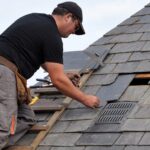Every homeowner knows the sinking feeling that comes with discovering a roof leak. It’s crucial to address these leaks promptly to prevent any further damage to your home. In this article, we’ll explore how to patch a leaky roof effectively while introducing you to some tremendous techniques and tips.

Understanding the Source of the Leak
Before you can patch a leaky roof, you need to identify the source of the leakage. Water stains on your ceiling might not correspond with the actual leak location. It’s essential to inspect your roof thoroughly or hire a professional to locate the specific entry point.
Tools and Materials You’ll Need
- Ladder
- Roofing cement
- Roofing nails
- Hammer
- Wire brush
- Roofing tape
- Pry bar
The Steps: Patching Your Roof
1. Safety First
Before you begin, ensure that you have all the necessary safety equipment. This includes a sturdy ladder, non-slip shoes, and possibly a safety harness if you’re dealing with a steep roof.
2. Remove Debris
Clear away any debris from your roof. This will not only make your work area cleaner but also allow you to inspect the roof’s surface more closely for any signs of damage.
3. Secure Loose Roofing
If you find any loose shingles, secure them with roofing nails. This will prevent further movement and minimize the severity of the leak.
4. Apply Roofing Cement
Using a roofing cement, seal the edges of the damaged area. This is a preliminary step to help prevent additional water from seeping through while you work on a more extensive repair.
5. Install Roofing Tape
Once the cement has dried, apply roofing tape over the patched area. This tape adds an extra layer of protection and helps to keep the patch in place.
When to Call a Professional
While some roof leaks can be repaired with DIY techniques, there are situations where calling in a professional is the best course of action. Consider contacting a roofing expert if:
- The leak sources are not easily identifiable.
- The damage seems extensive.
- You feel uncomfortable or unsafe conducting the repairs.
Understanding Roof Maintenance
Regular roof maintenance can help prevent leaks from occurring in the first place. This includes cleaning gutters, trimming overhanging branches, and inspecting your roof after severe weather conditions.
Preventive Measures
Prevention is always better than cure. Here are some preventive measures to keep your roof in a good condition:
- Regular inspections to identify potential weak spots.
- Ensuring proper attic ventilation to avoid moisture buildup.
- Investing in quality roofing materials for durability.
Common Causes of Roof Leaks
Understanding the common causes of roof leaks can help you take action before they become a problem. Some reasons include:
- Broken or missing shingles.
- Clogged gutters causing water to pool.
- Poor flashing installation around chimneys or vents.
Types of Roofing Materials and Their Durability
Different roofing materials have varying levels of protection and durability. It’s crucial to know the type of material your roof is made from:
- Asphalt Shingles: Common but may require more frequent repairs.
- Metal Roofs: Durable and resistant to leaks when properly installed.
- Tile Roofing: Long-lasting but can be prone to cracking.
Additional Resources
For a deeper understanding of roof maintenance and repair, you might want to visit here or read this article about drip edge installation.
Conclusion
Tackling a leaky roof can seem daunting, but with the right guidance and tools, it’s manageable. We’ve discussed how to patch a leaky roof, which ensures that you can take immediate action to protect your home.

Frequently Asked Questions
1. How do I know if my roof has a leak?
Signs of a roof leak include water stains on ceilings, moldy smells, and visible roof damage.
2. Can I patch a leaky roof myself?
Yes, small leaks can often be patched with DIY methods. However, large or complex leaks are best handled by professionals.
3. What is the cost of professional roof repair?
Professional repair costs vary depending on the extent of the damage and your location. It’s best to get several quotes and refer to resources like this guide for a detailed cost breakdown.
This article contains affiliate links. We may earn a commission at no extra cost to you.








